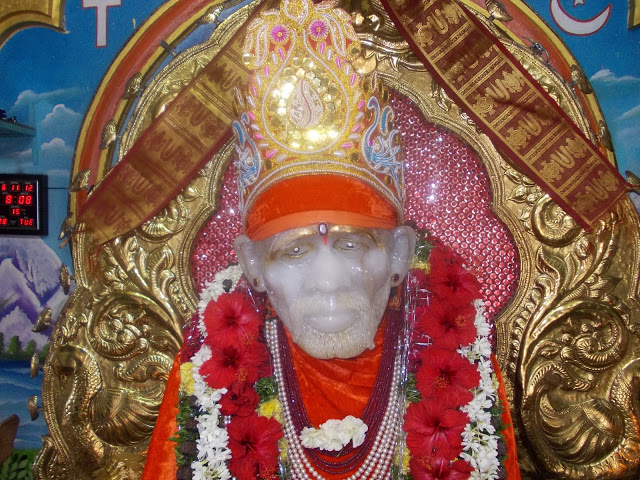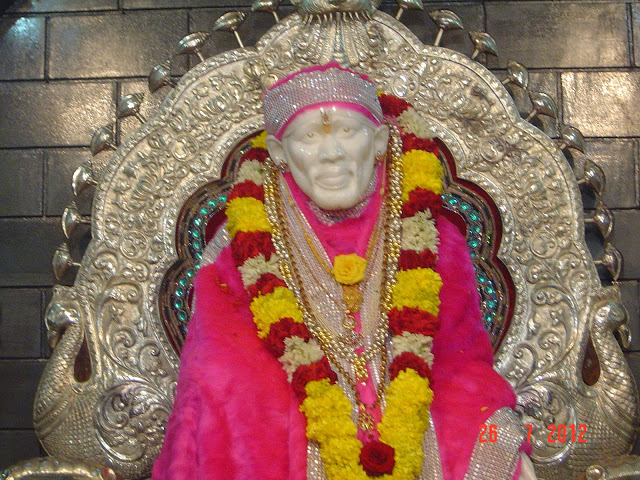SHRI SHIRDI SAIBABA
SAMADHI MANDIR
· The shrine which houses Baba’s tomb was
originally constructed as a wada (large private house) during Baba’s last years
of physical presence. It is built on the same land that Baba had tended as a
garden. The shrine was built by a wealthy devotee from Nagpur, Gopalrao Booty.
The wada was originally intended as a rest house and temple for Muralidhar. The
inspiration for the building came to Booty in a dream, when he was sleeping beside
his friend and fellow devotee, Shama. Baba appeared and told him to build a
house and temple. It is a perfect sai-incidence that Shama had the same dream
as Booty had. Deeply touched, they commenced the activities for constructing
the wada, took the sketches to Dixit for approval and then went to Baba for
blessings. Baba responded warmly and gave His blessing to the project. The work
commenced around 1915. It was built in stone and was therefore known as dagadi
(stone) wada. Shama supervised the construction of the basement, ground floor
and well. Later, Bapusaheb took over job of supervising the work. On Oct 15,
1918 Baba lay with His body fading fast. His last words were,”I am not feeling
well in the masjid. Carry me to the dagadi wada”. Baba was indeed carried to
the wada, and was buried in the place where the image of Muralidhar was to have
been placed: an edifice was later raised over the tomb. The burial was
completed by early Thursday morning. A photograph of Sai Baba was placed on a
throne on the platform of the tomb. It remained there until the statue was
installed in 1954. That picture is now kept in the recess of the Samadhi Mandir
for display.
· The statue, which has become such a famous
and well-loved image of Baba, was not installed until 1954, thirty-six years
after His mahasamadhi, and there is an intriguing story behind it. Some white
marble arrived from Italy at the Bombay docks, but nobody seemed to know
anything about it or who it was for, or why it had come. In the absence of a
claimant, the dockyard auctioned it and the purchaser offered it to the Shirdi
Sansthan (temple authorities). Impressed by the quality of the marble, they
wanted to use it for an idol of Baba and gave the commission to a sculpture
from Bombay, Balaji Vasant Talim. However, the latter had only one black and
white photo of Baba as his model, and was struggling to get the likeness. One
night Baba came to him in a dream, remarked on his difficulties and then showed
him His face from various angles, encouraging Talim to study it thoroughly and
remember it well. This gave Talim the fillip he needed and after that the work
flowed easily and the result exceeded all expectations. The statue was
installed on Oct 7, 1954, on the auspicious day of Vijayadasami. As the main object
of adoration in Shirdi, the idol is accorded all due honors. Out of their love
for Baba, devotees wish to provide every comfort and respect they can. Baba
sits relaxed, natural and majestic, gazing benignly on the millions of diverse
visitors who flock to him for succor. The lifelike quality of the eyes really
does seem to be looking at us and responding! The feeling and experience that
Baba is still alive and present pervades all the Sansthan facilities and
activities of His devotees. The same sentiment is seen in entire Shirdi and
contributes to the mystique and magic of what we call Shirdi.
· The temple premise of Shri Saibaba Sansthan
is spread in approximately in 2150sq.ft. It is situated in the heart of Shirdi
village and is a major center of pilgrims from all over the world. Along with
the Samadhi Mandir, the temple complex also has Khandoba Temple, Gurusthan,
Dwarakamai, Chavadi, Lendi Gardens and other temples like Hanuman Mandir,
Mahalakshmi Temple, Narasimha Temple and Jain Temple. On an average, daily
25,000 devotees visit Shirdi village, to have the Darshan of Shri Sai Baba. In
the festival season, more than 1,00,000 devotees visit the Temple every day.
The Temple premise is renovated in the year 1998-99 and is now equipped with
all necessary facilities like Darshan Lane, Prasadalay (Lunch and Dinner),
Donation Counters, Prasad Counters, Canteen, Railway Reservation Counter, Book
Stall etc.
Weekly Activities
- Chavadi
procession (palanquin procession) is organized every Thursday at 9:15pm.
In the evening, Baba’s satka and padukas are displayed in front of His
sacred tomb from 7:30pm, until they are carried out at the beginning of
the procession at 9pm. Devotees in Samadhi Mandir are allowed to pay their
respects to these sacred objects, which are accessible only at this time.
- At
about 9:15pm, the procession moves out of the Samadhi Mandir, to a flurry
of horns, cries and waving fans. At the centre is the garlanded portrait
of Baba from Chavadi carried reverently by the great-grandson of one of
Baba’s dearest devotees, Tatya Kote Patil, and another of his relatives.
They are preceded by one of the temple staff carrying the padukas and
satka. The procession enters Dwarkamai and about ten minutes later, and
the photo is placed on the decorated silver palanquin to the accompaniment
of more exuberant bhajan. In about fifteen minutes, temple staff and
locals then carry the palanquin to Chavadi.
- As
the palanquin approaches Chavadi, procession reaches the climax of the
evening. The palanquin is parked outside, and the picture, draped in gold
embroidered red velvet, is carried inside Chavadi and greeted as if Baba
himself were entering. Baba’s picture is then settled into place on a
silver throne and arati is performed. Finally, the whole group returns to
the Samadhi Mandir. Here, a local person receives the satka and padukas,
and the Kote brothers hand back the picture and collect a coconut as
prasad. The prasad is kept beside Baba’s statue until the final night
arati is over. The picture is returned to Chavadi after morning arati the
next day. Chavadi procession is taken along the path that Baba walked by
foot nearly hundred years ago.
Special Activities
- The
Shirdi Saibaba Sansthan Trust celebrates three major festivals, Sri
Ramanavami, Guru Purnima, and Vijayadasami every year. These festivals are
celebrated with great passion, verve and happiness. Several thousand
devotees flock to bathe in the grace and to receive blessings from Sri Sai
Baba.
- Temple
organizes puja, bhajan, public parayana (reading of scriptures and
devotional texts) and exuberant processions with the palanquin and the
rath (chariot procession). The Samadhi Mandir remains open all night
during these festivals.
- Other
prominent Hindu festivals like Maha Sivaratri, Gudhi Padwa, Datta
Jayanthi, and New Year are also celebrated.
Social Activities
- Shri
Saibaba Sansthan Trust, Shirdi, is the authorized body to control and
manage the day-to-day activities at the Shri Saibaba Samadhi Mandir and
other temples in the premise. It also provides various facilities like
accommodation, lunch (at economical rates), refreshments, railway
reservations, and lot more.
- The
Sansthan Trust also runs Kanya Shala (Girls School) and English Medium
School, Hospital, Blood Bank, Industrial Training Institute (I. T. I.),
Drinking Water supply, etc.
- The
Sansthan Trust also participates in the development of Shirdi Village.
Recently Sansthan Trust has paid money for the development of Drinking
Water Scheme for Shirdi Village.
Mandir Timings
|
All Days
|
04:00 AM - 11:15 PM
|
Arati Timings
|
Day
Kakad Arati
Madhyahn Arati
Dhup Arati
Sej Arati
|
All Days
04:30 AM
12:00 PM
Sunset
10:30 PM
|
7 / 7
Address
Shirdi
Rahata Tal
Ahmednagar (Dist) 423109
Maharashtra















